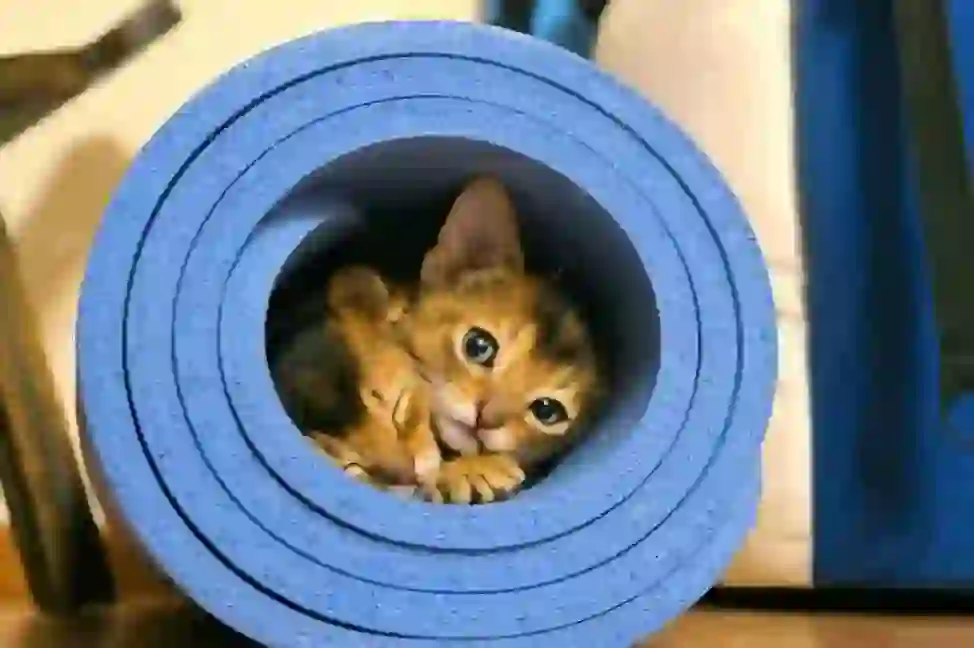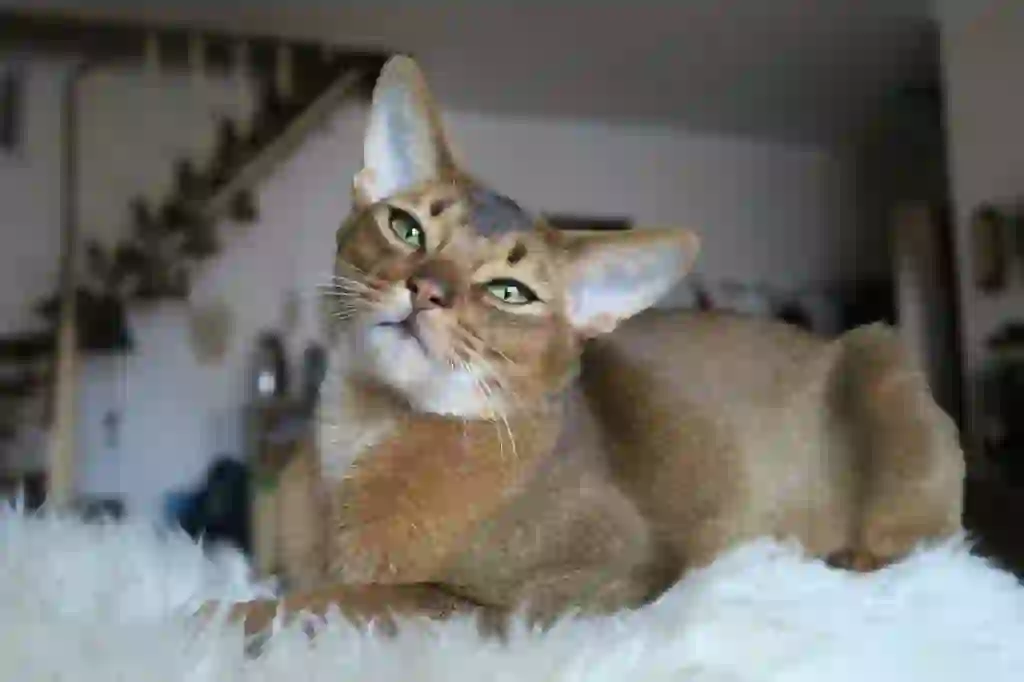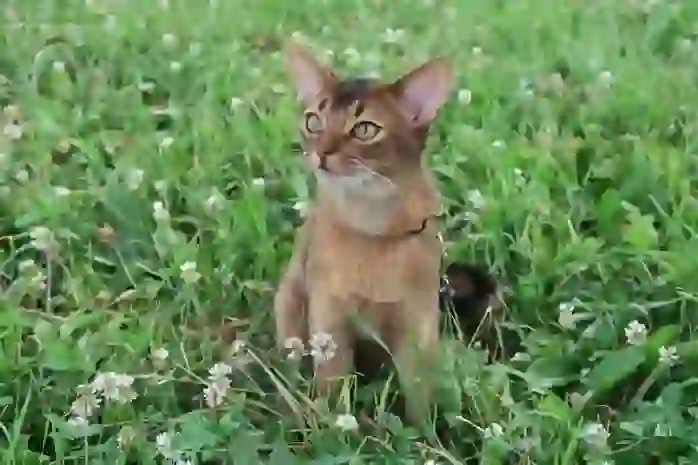
Abyssinian
Abyssinian
Abyssinian
Which cat embodies a certain elegance and beauty? That's right! The 'Abyssinian.' While it's not certain, there is a legend that the Abyssinian was one of the cats loved by Cleopatra, who is counted among the world's three great beauties. They may not be flashy, but they have a unique fur color that is absolutely beautiful! Why not delve into the secrets of the Abyssinian on this page right away?
Abyssinian Basic Infomation

Country of Origin: United Kingdom
Weight: 3–5 kg
The Abyssinian is a naturally occurring breed of cat. There are various theories about its origins, which are very ancient. Notably, because cats depicted in ancient Egyptian murals closely resemble the Abyssinian, it was long believed to originate from Egypt.
However, recent genetic studies suggest the possibility that the Abyssinian's ancestors were indigenous cats living in the Bengal region of India. It has also been discovered that they are closely related to the Libyan wildcat. Although many details of its origins remain unclear, it was in the United Kingdom that the Abyssinian as a breed was first established. Hence, its country of origin is considered to be the United Kingdom.
It is said that after the Abyssinian War (in present-day Ethiopia) in 1868, British soldiers brought back cats living in that area and bred them with local cats, leading to the creation of the Abyssinian. Another theory suggests that the breed was actually developed from 'Rabbit Cats' already present in the UK, which were crossed with cats having brown and silver coats.
Regardless, the Abyssinian made its debut at cat shows in the 1870s and was registered with the GCCF in the UK. This spurred the beginning of formal breeding in France, and the breed later made its way to the United States, and eventually to countries around the world like Japan and Australia, becoming a globally beloved cat.
Abyssinian Q&A

What is the origin of the Abyssinian's name?
The name comes from cats that were brought back from the Abyssinian War, hence the name.

What does an Abyssinian look like?
They have a wedge-shaped head, almond-shaped large eyes, and large ears that taper at the tips. Their body type is called 'foreign.' They are known for their well-muscled, athletic bodies and fur that is soft and silky to the touch. The color of their coat can appear to change depending on the lighting and their movement. They have long, slender legs that make them appear to be standing on tiptoe, earning them the nickname 'ballet cat.'

How much does it cost to buy an Abyssinian?
Purchasing from a breeder or cattery costs about 50,000 to 200,000 yen. It's a good idea to visit and see your favorite kitten in person before deciding.
At pet shops, the price ranges from 150,000 to 300,000 yen. However, some shops may breed indiscriminately, so it's best to avoid buying from shops with unclear breeding practices.
Buying from a cattery, which is a higher qualification than a general breeder, can be more expensive. Catteries require accreditation from pedigree issuing bodies such as CAF or TICA, indicating higher reliability and added value.
Other factors that can affect the price include whether the cat is a kitten, has excellent lineage, or has rare colors or patterns.

What is the difference between an Abyssinian and a Somali?
The Somali is essentially a long-haired version of the Abyssinian, so apart from their fur, the two breeds are almost identical. Both are of the foreign type and have similar weights.
The Abyssinian is short-haired, while the Somali is long-haired, with a bushy tail, requiring more grooming. They also share the same color patterns.
Both breeds have a charming, bell-like vocalization. They tend to be curious, friendly, and affectionate.

I want to know more about the Abyssinian's personality and characteristics!
Contrary to their model-like appearance, Abyssinians are active and curious cats. They are friendly and affectionate, making them a great choice for those who want to interact closely with their cat.
They enjoy climbing high places and playing with balls, so having a cat tower is recommended. Avoid placing items on high furniture as they may climb and cause accidents.
Abyssinians are known for their beautiful, bell-like voices. For those interested, there are videos online capturing their unique sounds.
Their curiosity and intelligence, along with their slender build, often lead them to escape through small openings. Extra caution is advised near doors and windows.
No specific preventative measures are known for some of the diseases they are prone to, such as pyruvate kinase deficiency and myasthenia gravis, which often requires medication or treatment if tumors are the cause.

What are common health issues in Abyssinians?
Abyssinians are prone to periodontal disease, pyruvate kinase deficiency, and myasthenia gravis.
Periodontal disease is an inflammatory condition caused by bacteria between the teeth and gums. It's often a result of plaque and tartar buildup but can also be caused by tumors or other infectious diseases. Bad breath or bleeding from the teeth are signs to visit a vet.
Pyruvate kinase deficiency can lead to anemia and may be fatal if not diagnosed early. It's caused by a lack of the enzyme 'pyruvate kinase,' leading to the destruction of red blood cells.
Myasthenia gravis causes muscle weakness, making it difficult for affected cats to swallow or eat. This disease is largely genetic, and no specific prevention is known. Treatment typically involves medication, and in cases caused by tumors, the primary treatment would be for the tumor.

What is the lifespan of an Abyssinian?
The lifespan of an Abyssinian is about 10 to 13 years, which is slightly shorter than the average lifespan for cats.

Would you like to become a part of the 'Animalbook.jp'?
Turn your knowledge into Q&A and share it with the world. ※Publication will be activated after purchase. Let's share information together!
Abyssinian Type of List

- Abyssinian
Information
Congratulations! You are the first commenter!

Create Your Favorite List!
Abyssinian
Save the animals you love! Build your own list to quickly revisit your favorites later.

Would you like to leave a comment?
※Please note: This is for the purchase of rights to post comments within the article.
Find Your Favorites!
Our shop offers a unique and attractive selection of goods themed around various animals.
Abyssinian References

- まるごとわかる猫種大図鑑 監修:CFA公認審査員 早田由貴子
- 世界中で愛される美しすぎる猫図鑑 監修 今泉忠明
- The Cat Fancier's Association, Inc. https://cfa.org/abyssinian/
- 猫との暮らし大百科 https://www.anicom-sompo.co.jp/nekonoshiori/
- みんなの猫図鑑 https://www.min-nekozukan.com/
- Pet Smile news forネコちゃん http://psnews.jp/cat/
- 子猫のへや https://www.konekono-heya.com/sitemap.html
- ねこちゃんホンポ https://nekochan.jp/
- 公益社団法人 埼玉県獣医師会 https://www.saitama-vma.org/topics/猫の遺伝性疾患について/
- RIKA りか動物病院 猫の歯周病のお話 http://rika-ah.com/byouki/byouki25.html
Abyssinian Introduction of media used

出典:https://pixabay.com/images/id-2136798/

出典:https://pixabay.com/images/id-4911862/

出典:https://pixabay.com/images/id-2754331/

出典:https://pixabay.com/images/id-4913367/

出典:https://commons.wikimedia.org/wiki/File:Kamee02.jpg

出典:https://pixabay.com/images/id-4915993/

出典:https://pixabay.com/images/id-5313506/

similar
出典:https://commons.wikimedia.org/wiki/File:Blue_Somali_kitten_age_3_months.jpg

出典:https://pixabay.com/images/id-4915928/

出典:https://pixabay.com/images/id-4913361/

出典:https://pixabay.com/images/id-4914687/

Help Enrich Our Animalbook.jp with Your Media!
We are constantly looking to expand and enrich our Animalbook.jp with amazing photos and videos of animals. If you have any media that you'd like to share, please contribute and help us showcase the beauty and diversity of the animal kingdom. Your submissions will be credited and featured in our encyclopedia, reaching a wide audience of animal lovers.


















